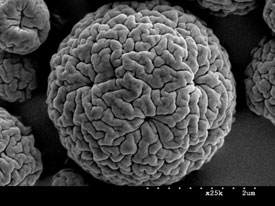| 2003 |

|
YEAR BOOK |
Trinity College Dublin
|
Processing and characterisation of pharmaceutical solids
|

In the Department of Pharmaceutics and Pharmaceutical Technology, TCD, Professor Owen Corrigan and Dr Anne Marie Healy have an interest in various particle formation and solid processing techniques - in particular spray drying, freeze drying and supercritical fluid technologies.
A current programme of research within the Department is aimed at gaining a better understanding of spray drying as a particle formation process and, in particular, at the potential for co-spray drying materials to produce composite solids, which in many cases have optimal biopharmaceutical properties.
The rapid drying process associated with spray drying can result in a more disordered form of a normally crystalline drug or composite. The spray drying process can result in polymorph or solvate formation and, in some cases, amorphous or glassy material may be formed. Amorphous materials may be advantageous in terms of their increased solubility and dissolution rate, relative to the crystalline form of the material, which can lead to improved bioavailability. However, there is frequently a reluctance to include an amorphous form of a drug in a pharmaceutical product due to the possibility of recrystallisation.
A focus of the current research is to examine co-spray drying with suitable polymers as a means of stabilising the amorphous form of the drug. We are also interested in developing ways of predicting the stability of an amorphous mixed composite, based on the glass transition temperatures (Tgs) of the individual components. The Tg is an important determinant of the stability of amorphous systems and represents the boundary where the physical properties of the glass change radically. The ability to predict amorphous stability will aid in the design of novel formulations of amorphous materials with improved bioavailability, as well as adequate long-term stability under suitable storage conditions.
Contact: Dr Anne Marie Healy, Department of Pharmaceutics and Pharmaceutical Technology,
School of Pharmacy, TCD;
E-mail: [email protected]